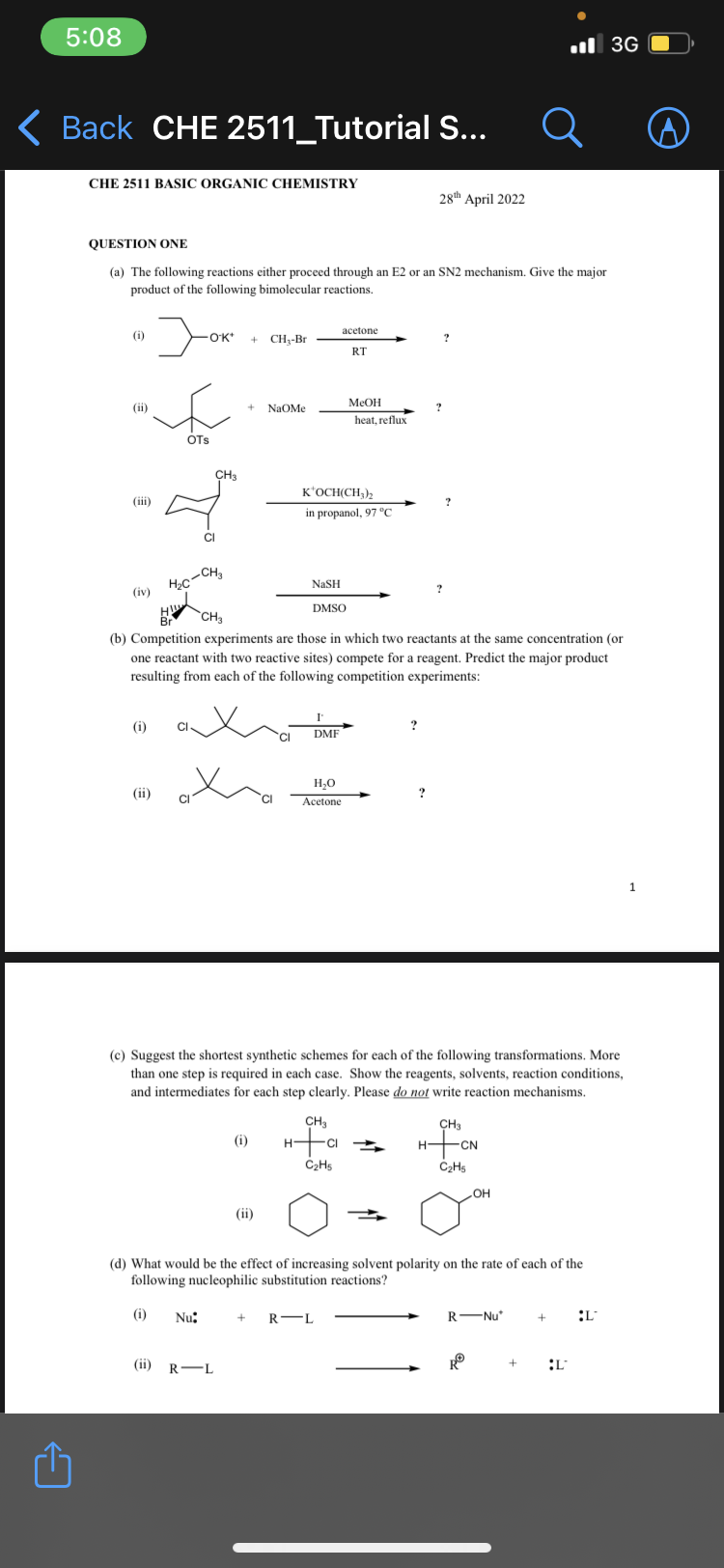5:08 Back CHE 2511_Tutorial S... CHE 2511 BASIC ORGANIC CHEMISTRY QUESTION ONE (a) The following reactions either proceed through an E2 or an SN2 mechanism. Give the major product of the following bimolecular reactions. (i) (ii) (iv) Jok (ii) E OTS (i) CI *OK* + CH₂-Br H₂C-CH₂ CI CH3 x (i) Nu: + (ii) R-L NaOMe (i) (ii) H Br CH3 (b) Competition experiments are those in which two reactants at the same concentration (or one reactant with two reactive sites) compete for a reagent. Predict the major product resulting from each of the following competition experiments: NaSH DMSO K'OCH(CH3)2 in propanol, 97 °C I DMF acetone H₂O Acetone CH3 RT H+CI C₂H5 MeOH heat, reflux (c) Suggest the shortest synthetic schemes for each of the following transformations. More than one step is required in each case. Show the reagents, solvents, reaction conditions, and intermediates for each step clearly. Please do not write reaction mechanisms. + R-L 28th April 2022 ? ? ? ? (d) What would be the effect of increasing solvent polarity on the rate of each of the following nucleophilic substitution reactions? CH3 HCN C₂H5 OH R-Nu RⓇ + 3G + :L L 1 A
5:08 Back CHE 2511_Tutorial S... CHE 2511 BASIC ORGANIC CHEMISTRY QUESTION ONE (a) The following reactions either proceed through an E2 or an SN2 mechanism. Give the major product of the following bimolecular reactions. (i) (ii) (iv) Jok (ii) E OTS (i) CI *OK* + CH₂-Br H₂C-CH₂ CI CH3 x (i) Nu: + (ii) R-L NaOMe (i) (ii) H Br CH3 (b) Competition experiments are those in which two reactants at the same concentration (or one reactant with two reactive sites) compete for a reagent. Predict the major product resulting from each of the following competition experiments: NaSH DMSO K'OCH(CH3)2 in propanol, 97 °C I DMF acetone H₂O Acetone CH3 RT H+CI C₂H5 MeOH heat, reflux (c) Suggest the shortest synthetic schemes for each of the following transformations. More than one step is required in each case. Show the reagents, solvents, reaction conditions, and intermediates for each step clearly. Please do not write reaction mechanisms. + R-L 28th April 2022 ? ? ? ? (d) What would be the effect of increasing solvent polarity on the rate of each of the following nucleophilic substitution reactions? CH3 HCN C₂H5 OH R-Nu RⓇ + 3G + :L L 1 A
Chemistry
10th Edition
ISBN:9781305957404
Author:Steven S. Zumdahl, Susan A. Zumdahl, Donald J. DeCoste
Publisher:Steven S. Zumdahl, Susan A. Zumdahl, Donald J. DeCoste
Chapter1: Chemical Foundations
Section: Chapter Questions
Problem 1RQ: Define and explain the differences between the following terms. a. law and theory b. theory and...
Related questions
Question
100%

Transcribed Image Text:5:08
Back CHE 2511_Tutorial S...
CHE 2511 BASIC ORGANIC CHEMISTRY
QUESTION ONE
(a) The following reactions either proceed through an E2 or an SN2 mechanism. Give the major
product of the following bimolecular reactions.
(i)
(ii)
(iv)
Jok
(ii)
E
OTS
(i) CI
*OK* + CH₂-Br
H₂C-CH₂
CI
CH3
x
(i) Nu:
+
(ii) R-L
NaOMe
(i)
(ii)
H
Br
CH3
(b) Competition experiments are those in which two reactants at the same concentration (or
one reactant with two reactive sites) compete for a reagent. Predict the major product
resulting from each of the following competition experiments:
NaSH
DMSO
K'OCH(CH3)2
in propanol, 97 °C
I
DMF
acetone
H₂O
Acetone
CH3
RT
H+CI
C₂H5
MeOH
heat, reflux
(c) Suggest the shortest synthetic schemes for each of the following transformations. More
than one step is required in each case. Show the reagents, solvents, reaction conditions,
and intermediates for each step clearly. Please do not write reaction mechanisms.
+ R-L
28th April 2022
?
?
?
?
(d) What would be the effect of increasing solvent polarity on the rate of each of the
following nucleophilic substitution reactions?
CH3
HCN
C₂H5
OH
R-Nu
RⓇ
+
3G
+ :L
L
1
A
Expert Solution
This question has been solved!
Explore an expertly crafted, step-by-step solution for a thorough understanding of key concepts.
This is a popular solution!
Trending now
This is a popular solution!
Step by step
Solved in 2 steps with 2 images

Knowledge Booster
Learn more about
Need a deep-dive on the concept behind this application? Look no further. Learn more about this topic, chemistry and related others by exploring similar questions and additional content below.Recommended textbooks for you

Chemistry
Chemistry
ISBN:
9781305957404
Author:
Steven S. Zumdahl, Susan A. Zumdahl, Donald J. DeCoste
Publisher:
Cengage Learning

Chemistry
Chemistry
ISBN:
9781259911156
Author:
Raymond Chang Dr., Jason Overby Professor
Publisher:
McGraw-Hill Education

Principles of Instrumental Analysis
Chemistry
ISBN:
9781305577213
Author:
Douglas A. Skoog, F. James Holler, Stanley R. Crouch
Publisher:
Cengage Learning

Chemistry
Chemistry
ISBN:
9781305957404
Author:
Steven S. Zumdahl, Susan A. Zumdahl, Donald J. DeCoste
Publisher:
Cengage Learning

Chemistry
Chemistry
ISBN:
9781259911156
Author:
Raymond Chang Dr., Jason Overby Professor
Publisher:
McGraw-Hill Education

Principles of Instrumental Analysis
Chemistry
ISBN:
9781305577213
Author:
Douglas A. Skoog, F. James Holler, Stanley R. Crouch
Publisher:
Cengage Learning

Organic Chemistry
Chemistry
ISBN:
9780078021558
Author:
Janice Gorzynski Smith Dr.
Publisher:
McGraw-Hill Education

Chemistry: Principles and Reactions
Chemistry
ISBN:
9781305079373
Author:
William L. Masterton, Cecile N. Hurley
Publisher:
Cengage Learning

Elementary Principles of Chemical Processes, Bind…
Chemistry
ISBN:
9781118431221
Author:
Richard M. Felder, Ronald W. Rousseau, Lisa G. Bullard
Publisher:
WILEY